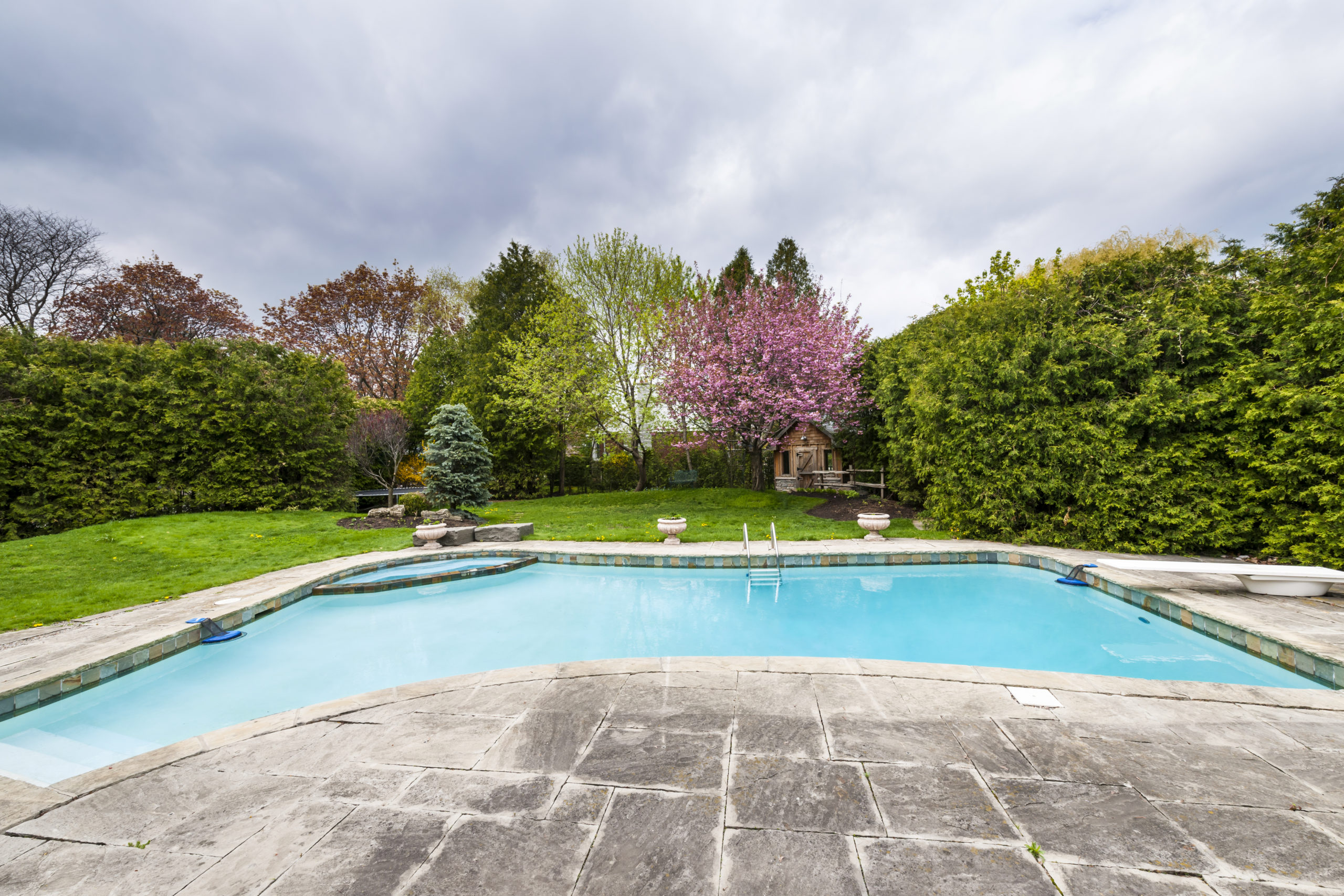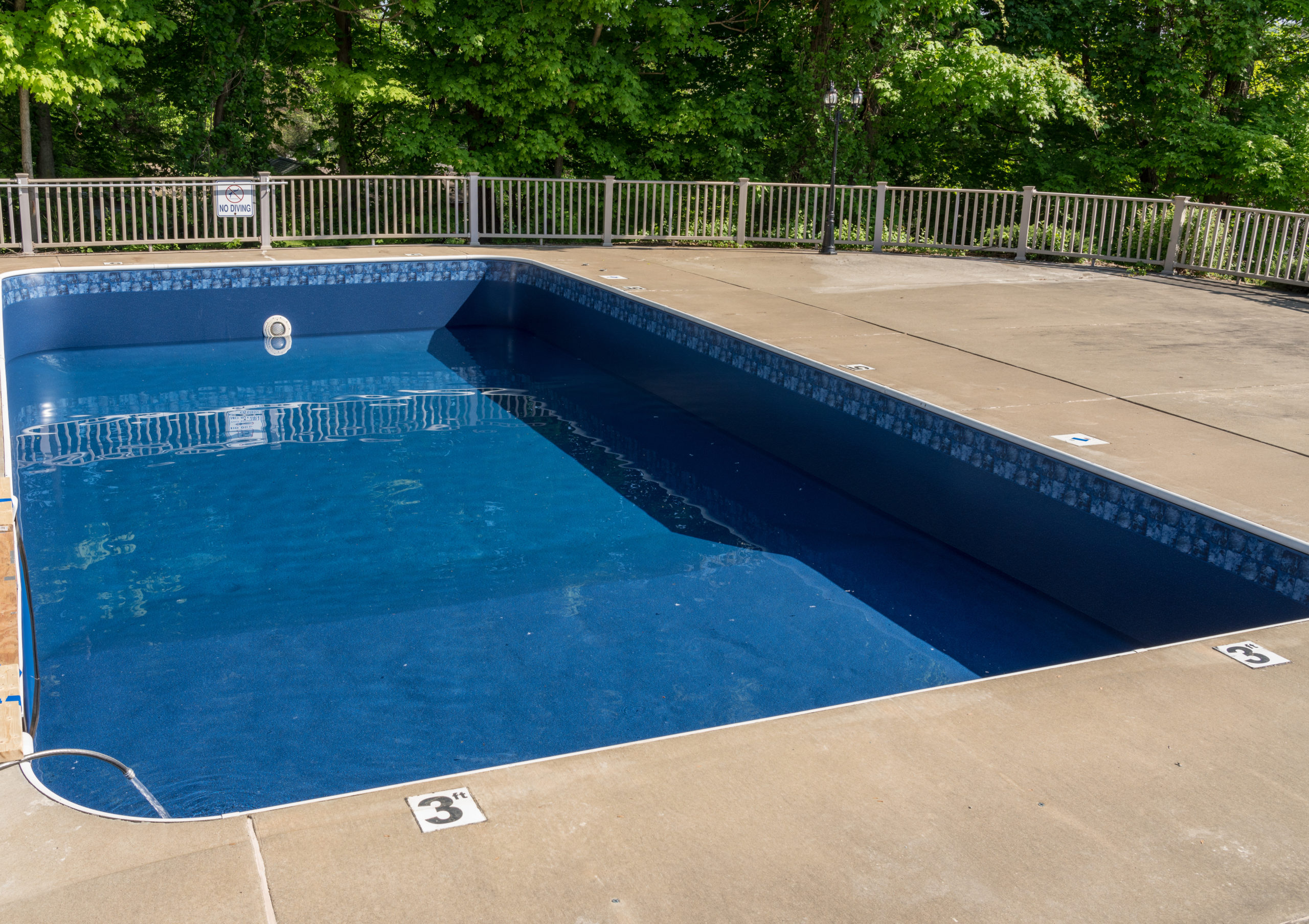You’re planning your dream pool, but can’t decide on the material? Don’t fret! This article will guide you through the pros and cons of concrete, fiberglass, vinyl liner, and natural stone pools.
We’ll delve into each option’s strengths and weaknesses to help you make an informed choice.
Dive in to find out which pool material matches your needs perfectly.
Exploring the Features of Concrete Pools
Let’s delve into the features of concrete pools, shall we?

The main attraction of a concrete pool is its flexibility in design. You’re not limited to pre-set shapes or sizes, as with some other materials. A well-executed concrete pool design allows you to integrate seamlessly with your existing landscape, offering you limitless aesthetic possibilities.
However, it’s essential to understand that this beauty comes at a cost: concrete pool maintenance. While all pools require upkeep, it’s particularly crucial for concrete ones. They’re susceptible to algae growth due to their porous surface and need regular brushing. Periodic acid washing is also needed to prevent staining and maintain its appealing look.
Moreover, another significant aspect of concrete pool maintenance involves checking and repairing any cracks or chips promptly. Water can seep through these defects causing structural damage if neglected.
Your choice in a concrete pool means committing time and resources towards regular maintenance but rewards you with an aesthetically pleasing structure tailored specifically for your space. It provides durability and longevity unmatched by many other materials when adequately maintained.
In essence, understanding these aspects equips you with the knowledge required for owning a stunning yet demanding feature like a concrete pool.
Understanding the Benefits and Drawbacks of Fiberglass Pools
You’re probably wondering about the upsides and downsides of fiberglass swimming holes. Let’s dive into the details.
One key advantage of fiberglass pools is their durability. Fiberglass, a robust material, withstands harsh environmental conditions, making it a reliable choice for your pool surface. The smooth finish also minimizes algae growth, saving you time on maintenance tasks.
Another point in favor of fiberglass lies in its installation ease. Unlike concrete or vinyl liner pools that require weeks to install, a professional crew can have a fiberglass pool ready in just a few days.
However, they aren’t without drawbacks. Firstly, although durable, they lack the customization options offered by other materials like concrete – you’re limited to premanufactured shapes and sizes. Secondly, while upfront costs may be less due to installation ease, over time these pools can develop cracks or shifts due to soil conditions or heavy loads above ground level.
Understanding these benefits and drawbacks will help you make an informed choice about whether a fiberglass pool aligns with your needs and expectations.
Delving Into the Pros and Cons of Vinyl Liner Pools
Shifting gears, let’s now examine vinyl liner swimming spots, which come with their own set of advantages and disadvantages.
A key benefit is the flexibility in design; you’re not restricted to a specific shape or size. This offers you the freedom to tailor your pool to your exact preferences.
But what about Liner Longevity? Well, that’s where it can get tricky. While they’re initially cheaper than other materials, vinyl liners generally require replacement every 5-9 years. The exact lifespan depends on factors like weather conditions and use patterns.
Maintenance Methods also differ significantly from other types of pools. Vinyl liners are prone to tears and punctures; hence, extra care should be taken when cleaning and using the pool area. You’ll need specialized equipment that won’t damage the liner surface.
Moreover, chemical balance is critical for these pools as high chlorine levels can bleach your liner over time.

The Strengths and Weaknesses of Natural Stone Pools
Diving into the world of natural stone swimming spots, there’s an array of strengths and weaknesses to consider. One major strength lies in the stone durability. Natural stone is built to last, withstanding harsh weather conditions and heavy usage over time.
The aesthetic versatility of natural stone pools is another significant advantage. You can choose from a variety of stones and finishes to suit your personal style or match your home’s architectural design.
Nevertheless, it’s important you’re aware of certain drawbacks:
– Cost: Natural stone pools tend to be more expensive than other materials.
– Upfront cost: The initial investment for a natural stone pool is high.
– Maintenance costs: Overtime, you’ll need to invest in upkeep like sealing or cleaning.
– Installation: These pools require professional installation which can be lengthy.
– Time: It will take longer compared to vinyl liner pools.
– Expertise: Specialized skills are needed ensuring correct installation.
Comparing and Contrasting the Different Pool Materials
It’s important to draw comparisons and contrasts between various options when selecting the right kind of swimming spot for your needs. When evaluating pool materials, two crucial factors you need to consider are material longevity and cost comparison.
Material longevity is a significant aspect as it directly impacts your pool’s lifespan. Concrete pools, for instance, are known for their durability and can last up to 50 years with proper maintenance. However, they require frequent resurfacing which can add to the overall costs. Vinyl liner pools might not last as long but they’re less expensive upfront and easier to install.
On the other hand, comparing costs reveals interesting insights. Fiberglass pools may have higher initial costs compared to vinyl or concrete counterparts due to their one-piece structure requiring specialized delivery and installation methods. But in terms of maintenance expenses, fiberglass tends out cheaper over time since it doesn’t necessitate liner replacements or resurfacing like other materials.
Therefore, understanding these trade-offs will guide you towards making an informed decision that aligns with your preferences and budget constraints. Remember that choosing the right material isn’t just about immediate gratification-it’s also about considering its long-term performance and financial implications.
Frequently Asked Questions
What Is the Average Lifespan of Each Type of Pool Material?
Concrete pools last 50+ years, fiberglass around 20, and vinyl liners need replacement every 5-9 years. Material durability affects lifespan significantly; pool aesthetics can also be influenced by material longevity.
Are There Any Environmental Impacts to Consider When Choosing a Pool Material?
Yes, environmental impacts are crucial to consider. Material sustainability and green alternatives play a big part in your choice. Some materials can be more eco-friendly than others, reducing your pool’s carbon footprint.
How Does the Maintenance Cost and Effort Vary Between Different Pool Materials?
Maintenance cost and effort can vary greatly between pool materials. Consider material durability and installation complexities. With concrete, you’ll deal with high maintenance, but fiberglass offers ease with fewer repairs over time.
What Pool Materials Are Best Suited for Harsh Weather Conditions or Changing Climates?
In harsh weather conditions, you’ll find concrete and fiberglass best due to their material durability and weather resilience. Concrete’s strong, adaptable nature and fiberglass’s resistance to temperature changes make them ideal for fluctuating climates.
Does the Choice of Pool Material Affect the Value of My Property?
Yes, your pool’s material can impact your property’s value. Material aesthetics greatly influence buyer perception, while certain materials boost resale prospects due to their longevity and ease of maintenance. Choose wisely for long-term investment.
